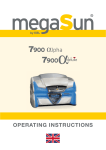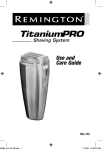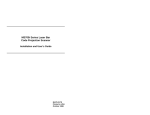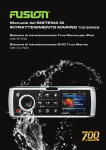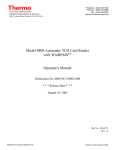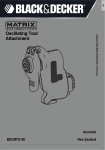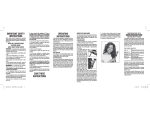Download Black & Decker 579208-00 Instruction Manual
Transcript
• Check for misalignment or binding of moving parts, breakage of parts, and any other condition that may affect the tools operation. If damaged, have the tool serviced before using. Many accidents are caused by poorly maintained tools. • Use only accessories that are recommended by the manufacturer for your model. Accessories that may be suitable for one tool, may become hazardous when used on another tool. M U LT I - S A N D E R / P O L I S H E R INSTRUCTION MANUAL Service • Tool service must be performed only by qualified repair personnel. Service or maintenance performed by unqualified personnel could result in a risk of injury. • When servicing a tool, use only identical replacement parts. Follow instructions in the Maintenance section of this manual. Use of unauthorized parts or failure to follow Maintenance Instructions may create a risk of electric shock or injury. Specific Safety Rules Catalog Number MS700 BEFORE RETURNING THIS PRODUCT FOR ANY REASON PLEASE CALL 1-800-54-HOW-TO (544-6986) IF YOU SHOULD EXPERIENCE A PROBLEM WITH YOUR BLACK & DECKER PRODUCT, CALL 1-800-54-HOW-TO (544-6986) BEFORE YOU CALL, HAVE THE FOLLOWING INFORMATION AVAILABLE, CATALOG No., TYPE No., AND DATE CODE (e.g. 0130M). IN MOST CASES, A BLACK & DECKER REPRESENTATIVE CAN RESOLVE YOUR PROBLEM OVER THE PHONE. IF YOU HAVE A SUGGESTION OR COMMENT, GIVE US A CALL. YOUR FEEDBACK IS VITAL TO BLACK & DECKER. KEY INFORMATION YOU SHOULD KNOW: • Regularly check wear on paper and replace worn paper. • The black pads are not abrasive surfaces–do not use this tool without properly attaching sandpaper to the pad. • Hold tool by insulated gripping surfaces when performing an operation where the cutting tool may contact hidden wiring or its own cord. Contact with a "live" wire will make exposed metal parts of the tool "live" and shock the operator. CAUTION: Wear appropriate personal hearing protection during use. Under some conditions and duration of use, noise from this product may contribute to hearing loss. WARNING: Some dust created by power sanding, sawing, grinding, drilling, and other construction activities contains chemicals known to cause cancer, birth defects or other reproductive harm. Some examples of these chemicals are: • lead from lead-based paints, • crystalline silica from bricks and cement and other masonry products, and • arsenic and chromium from chemically-treated lumber (CCA). Your risk from these exposures varies, depending on how often you do this type of work. To reduce your exposure to these chemicals: work in a well ventilated area, and work with approved safety equipment, such as those dust masks that are specially designed to filter out microscopic particles. • Avoid prolonged contact with dust from power sanding, sawing, grinding, drilling, and other construction activities. Wear protective clothing and wash exposed areas with soap and water. Allowing dust to get into your mouth, eyes, or lay on the skin may promote absorption of harmful chemicals. WARNING: Use of this tool can generate and/or disperse dust, which may cause serious and permanent respiratory or other injury. Always use NIOSH/OSHA approved respiratory protection appropriate for the dust exposure. Direct particles away from face and body. The label on your tool may include the following symbols. V ..........................volts A..........................amperes Hz ........................hertz W ........................watts min ........................minutes ......................alternating current no ........................no load speed ......................direct current ..........................Class II Construction ........................earthing terminal ........................safety alert symbol .../min ..................revolutions or reciprocations per minute 1 2 1 • Always hold your tool with two hands. 2 • Do not push down—let the sander do the work. • Extended drywall sanding is not recommended for this product. 5 3 SAVE THIS MANUAL FOR FUTURE REFERENCE. 6 VEA EL ESPAÑOL EN LA CONTRAPORTADA. INSTRUCTIVO DE OPERACIÓN, CENTROS DE SERVICIO Y PÓLIZA DE GARANTÍA. ADVERTENCIA: LÉASE ESTE INSTRUCTIVO ANTES DE USAR EL PRODUCTO. Catalog No. MS700 Form No. 579208-00 (FEB-02-1) Copyright © 2002 Black & Decker 4 9 Printed in China General Safety Rules WARNING: Read and understand all instructions. Failure to follow all instructions listed below may result in electric shock, fire and/or serious personal injury. 3 8 7 3 4 11 SAVE THESE INSTRUCTIONS Work Area • Keep your work area clean and well lit. Cluttered benches and dark areas invite accidents. • Do not operate power tools in explosive atmospheres, such as in the presence of flammable liquids, gases, or dust. Power tools create sparks which may ignite the dust or fumes. Use in well ventilated areas only. • Keep bystanders, children, and visitors away while operating a power tool. Distractions can cause you to lose control. 6 Electrical Safety • Double insulated tools are equipped with a polarized plug (one blade is wider than the other.) This plug will fit in a polarized outlet only one way. If the plug does not fit fully in the outlet, reverse the plug. If it still does not fit, contact a qualified electrician to install a polarized outlet. Do not change the plug in any way. Double insulation eliminates the need for the three wire grounded power cord and grounded power supply system. • Avoid body contact with grounded surfaces such as pipes, radiators, ranges and refrigerators. There is an increased risk of electric shock if your body is grounded. • Don’t expose power tools to rain or wet conditions. Water entering a power tool will increase the risk of electric shock. • Do not abuse the cord. Never use the cord to carry the tools or pull the plug from an outlet. Keep cord away from heat, oil, sharp edges or moving parts. Replace damaged cords immediately. Damaged cords increase the risk of electric shock. • When operating a power tool outside, use an outdoor extension cord marked "W-A" or "W." These cords are rated for outdoor use and reduce the risk of electric shock. 9 8 7 11 10 5 6 12 14 13 Personal Safety • Stay alert, watch what you are doing and use common sense when operating a power tool. Do not use tool while tired or under the influence of drugs, alcohol, or medication. A moment of inattention while operating power tools may result in serious personal injury. • Dress properly. Do not wear loose clothing or jewelry. Contain long hair. Keep your hair, clothing, and gloves away from moving parts. Loose clothing, jewelry, or long hair can be caught in moving parts. Air vents cover moving parts and should be avoided. • Avoid accidental starting. Be sure switch is off before plugging in. Carrying tools with your finger on the switch or plugging in tools that have the switch on invites accidents. • Remove adjusting keys or wrenches before turning the tool on. A wrench or key that is left attached to a rotating part of the tool may result in personal injury. • Do not overreach. Keep proper footing and balance at all times. Proper footing and balance enables better control of the tool in unexpected situations. • Use safety equipment. Always wear eye protection. Dust mask, non-skid safety shoes, hard hat, or hearing protection must be used for appropriate conditions. 7 8 1 2 Tool Use and Care • Use clamps or other practical way to secure and support the workpiece to a stable platform. Holding the work by hand or against your body is unstable and may lead to loss of control. • Do not force tool. Use the correct tool for your application. The correct tool will do the job better and safer at the rate for which it is designed. • Do not use tool if switch does not turn it on or off. Any tool that cannot be controlled with the switch is dangerous and must be repaired. • Disconnect the plug from the power source before making any adjustments, changing accessories, or storing the tool. Such preventative safety measures reduce the risk of starting the tool accidentally. • Store idle tools out of reach of children and other untrained persons. Tools are dangerous in the hands of untrained users. • Maintain tools with care. Keep cutting tools sharp and clean. Properly maintained tools, with sharp cutting edges are less likely to bind and are easier to control. 9 Motor Be sure your power supply agrees with nameplate marking. 120 Volts AC only means your tool will operate on standard 60 Hz household power. Do not operate AC tools on DC. A rating of 120 volts AC/DC means that your tool will operate on standard 60 Hz AC or DC power. This information is printed on the nameplate. Lower voltage will cause loss of power and can result in over-heating. All Black & Decker tools are factory-tested; if this tool does not operate, check the power supply. Use of Extension Cords Make sure the extension cord is in good condition before using. Always use the proper size extension cords with the tool – that is, proper wire size for various lengths of cord and heavy enough to carry the current the tool will draw. Use of an undersized cord will cause a drop in line voltage resulting in loss of power and overheating. For proper size cords see chart below. Minimum Gage for Cord Sets Volts Total Length of Cord in Feet 120V 0-25 26-50 51-100 101-150 240V 0-50 51-100 101-200 201-300 Ampere Rating More Not more American Wire Gage Than Than 0 - 6 18 16 16 14 6 - 10 18 16 14 12 10 - 12 16 16 14 12 12 - 16 14 12 Not Recommended OVERVIEW (Fig.1) 1. On/Off Switch 2. Dust cassette 3. Random orbit sanding base 4. Large detail sanding base 5. Finger attachment sanding base ASSEMBLY CAUTION: Before assembly, make sure that the tool is switched off and unplugged. Random orbit sanding base With this sanding base, you can use the tool as a random orbit sander. Fitting and removing the sanding base (Fig. 2) • • • • • Place the sanding base (3) onto the spindle (6). Place the washer (7) onto the spindle. Insert the allen screw (8) into the screw hole in the spindle. Tighten the allen screw using the hex wrench (9) supplied. To remove the sanding base, remove the allen screw (8) and washer (7). Fitting sanding discs • Hold the tool with the sanding base facing upwards. • Place the sanding disc onto the sanding base (3). The holes in the disc do not need to line up with the holes in the base. Large detail sanding base With this sanding base, you can use the tool as a detail sander or an orbital sander. Fitting and removing the sanding base (Fig. 3) • • • • • Place the sanding base (10) onto the spindle (6). Place the washer (7) onto the spindle. Insert the allen screw (8) into the screw hole in the spindle. Tighten the allen screw using the hex wrench (9) supplied. To remove the sanding base, remove the allen screw (8) and washer (7). Fitting sanding sheets (Fig. 4) • Detach the two diamond-shaped tips (11) from the sanding sheet (12). • Hold the tool with the sanding base facing upwards. • Place the sanding sheet (12) onto the sanding base making sure the holes in the sheet line up with the holes in the base. Diamond-shaped tips (Fig. 5) The diamond-shaped tips (13) can be reversed and replaced when worn. • When the front part of the tip is worn, detach it from the sheet, reverse it and press it onto the sanding base again. • When the whole tip is worn, remove it from the sanding base and fit a new tip. Finger base The finger base is used for fine detail sanding. The base attaches and removes the same as the round and large detail bases. The tips can be reversed and replaced when worn. Polishing bonnet and foam pad The polishing bonnet and foam pad attach to the round random orbit base. With the bonnet and pad, you can use the tool as a random orbit polisher. Fitting and removing the polishing bonnet and foam pad (Fig. 6) • Hold the tool with the round base facing upwards. • Place the bonnet or pad (14) onto the base making sure that it is centered. OPERATION Let the tool work at its own pace. Do not overload. Switching on and off (Fig. 7) • To switch the tool on, press the part of the on/off switch (1) marked “I”. • To switch the tool off, press the part of the on/off switch (1) marked “0”. Emptying the dust cassette (Fig. 8) The dust cassette should be emptied after every 10 minutes of use. • Pull the dust cassette (2) to the rear and off the tool. • Hold dust cassette with the outlet facing down and shake the cassette to empty the contents. • Refit the dustbag onto the tool. Dust Collection WARNING: Collected sanding dust from sanding surface coatings (polyurethane, linseed oil, etc.) can self-ignite in sander dust bag or elsewhere and cause fire. To reduce risk, empty bag frequently and strictly follow sander manual and coating manufacturer's instructions. CAUTION: When working on metal surfaces, do not use the dustbag or a vacuum cleaner because sparks are generated. Wear safety glasses and a dustmask. Due to the danger of fire, do not use your sander to sand magnesium surfaces. Do not use for wet sanding. Sanding Lead Base Paint Sanding of lead based paint is NOT RECOMMENDED due to the difficulty of controlling the contaminated dust. The greatest danger of lead poisoning is to children and pregnant women. Since it is difficult to identify whether or not a paint contains lead without a chemical analysis, we recommend the following precautions when sanding any paint: Personal Safety • No children or pregnant women should enter the work area where the paint sanding is being done until all clean up is completed. • A dust mask or respirator should be worn by all persons entering the work area. The filter should be replaced daily or whenever the wearer has difficulty breathing. NOTE: Only those dust masks suitable for working with lead paint dust and fumes should be used. Ordinary painting masks do not offer this protection. See your local hardware dealer for the proper (NIOSH approved) mask. • NO EATING, DRINKING or SMOKING should be done in the work area to prevent ingesting contaminated paint particles. Workers should wash and clean up BEFORE eating, drinking or smoking. Articles of food, drink, or smoking should not be left in the work area where dust would settle on them. Environmental Safety • Paint should be removed in such a manner as to minimize the amount of dust generated. • Areas where paint removal is occurring should be sealed with plastic sheeting of 4 mils thickness. • Sanding should be done in a manner to reduce tracking of paint dust outside the work area. Cleaning And Disposal • All surfaces in the work area should be vacuumed and thoroughly cleaned daily for the duration of the sanding project. Vacuum filter bags should be changed frequently. • Plastic drop cloths should be gathered up and disposed of along with any dust chips or other removal debris. They should be placed in sealed refuse receptacles and disposed of through regular trash pick-up procedures. During clean up, children and pregnant women should be kept away from the immediate work area. • All toys, washable furniture and utensils used by children should be washed thoroughly before being used again. Polishing NOTE: Although this discussion deals with polishing a car, your Multi-Tool is capable of polishing a wide array of flat surfaces such as hardwood floors, furniture, boats and other surfaces that could use an occasional shine. For best results, follow these simple steps to get a really professional looking job: 1. Wash The Car Wash the car with a mild detergent solution, by hand, starting on top surfaces and working down the sides. As each area is completed, rinse it thoroughly with clean water. Remove any buildup of road tar, insect spots and other foreign matter from the car using commercially available special cleaners. Use these cleaners only by hand. Make sure car surfaces are completely dry before starting to polish the car. NOTE: Do not polish any car in direct sunlight or when the body is hot. 2. Apply Liquid Wax Apply a small amount of liquid wax to the foam pad. Do not start the polisher until the pad is in contact with the car body. Starting the tool without this contact will cause spraying of the wax. NOTE: Too much liquid wax is wasteful and yields no benefit. It is also difficult to remove. 3. Apply To Car Turn the polisher on and move it over the work surface with side to side and front to back strokes. Simply guide the tool. Any extra pressure you apply will only slow the tool and yield an inferior result. Place the cord in a location which will avoid entanglement in the rotating pad. Apply more liquid wax as required to produce a light, uniform film (will appear as small ringlets on the work surface). Apply the liquid wax to the entire car. 4. Remove The Wax – Polishing Allow the applied liquid to dry thoroughly before starting to remove it and buff the car. Replace the foam pad with the polishing bonnet and move the tool over the car starting at the top and then down the sides. Let the weight of the tool do the work on the horizontal surfaces and use light pressure on the sides and other vertical surfaces. It is recommended that the fine dry dust left after removing the dried wax be removed by hand with a dry soft cloth. Additional Information and Tips for Polishing • Older car finishes may become oxidized or damaged by air pollutants, particularly on horizontal surfaces such as roofs, hoods, etc. These surfaces may have to be polished twice to restore the finish. For severe damage, only a professional car detailer or reconditioner may be able to restore the finish. • Removing wax which is not completely dry or allowing dried wax dust to build up on the car may clog the bonnet. If this happens remove the bonnet and shake hard to remove dried wax dust. • The chemical action of the cleaners and waxes and the speed of the polisher will do the work for you. Applying heavy pressure on the tool is not recommended. • Do not use to polish glass, vinyl tops or convertible tops. • When you are finished buffing, remove the bonnet from the polisher and allow the pad to air dry. Never store the tool resting on the side of the pad. Cleaning Bonnets Wash bonnets thoroughly in a strong solution of detergent and warm water. Floor cleaning detergents work best. Do not use detergents such as hand cleaners that contain abrasives. Do not machine wash. Additional Information and Tips for Sanding • Always hold the tool with both hands (Fig. 9). Do not place your hands over the ventilation slots. • Do not exert too much pressure on the tool. • Regularly check the condition of the sanding sheet. Replace when necessary. • Always sand with the grain of the wood. • Use extra fine grit when sanding new layers of paint before applying another layer. • On very uneven surfaces, or when removing layers of paint, start with a coarse grit paper. On other surfaces start with a medium grit. In both cases, gradually change to a fine grit for a smooth finish. Accessories Recommended accessories for use with your tool are available at extra cost from your local dealer or authorized service center. If you need assistance in locating any accessory for your tool, please call 1-800-54-HOW-TO (544-6986). CAUTION: The use of any other accessory not recommended for use with this tool could be hazardous. IMPORTANT: To assure product SAFETY and RELIABILITY, repairs, maintenance and adjustment should be performed by authorized service centers or other qualified service personnel, always using identical replacement parts. Service Information Black & Decker offers a full network of company-owned and authorized service locations throughout North America. All Black & Decker Service Centers are staffed with trained personnel to provide customers with efficient and reliable power tool service. Whether you need technical advice, repair, or genuine factory replacement parts, contact the Black & Decker location nearest you. To find your local service location, refer to the yellow pages directory under "Tools—Electric" or call: 1-800-54-HOW-TO (544-6986). Full Two-Year Home Use Warranty Black & Decker (U.S.) Inc. warrants this product for two years against any defects in material or workmanship. The defective product will be replaced or repaired at no charge in either of two ways. The first, which will result in exchanges only, is to return the product to the retailer from whom it was purchased (provided that the store is a participating retailer). Returns should be made within the time period of the retailer’s policy for exchanges (usually 30 to 90 days after the sale). Proof of purchase may be required. Please check with the retailer for their specific return policy regarding returns that are beyond the time set for exchanges. The second option is to take or send the product (prepaid) to a Black & Decker owned or authorized Service Center for repair or replacement at our option. Proof of purchase may be required. Black & Decker owned and authorized Service Centers are listed under "ToolsElectric" in the yellow pages of the phone directory. This warranty does not apply to accessories. This warranty gives you specific legal rights and you may have other rights which vary from state to state. Should you have any questions, contact the manager of your nearest Black & Decker Service Center. This product is not intended for commercial use. Black & Decker (U.S.) Inc., 701 E. Joppa Rd. Towson, MD 21286 U.S.A. See ‘Tools-Electric’ – Yellow Pages – for Service & Sales



